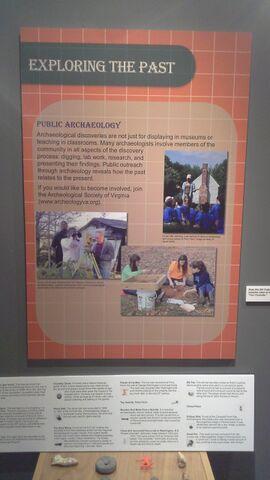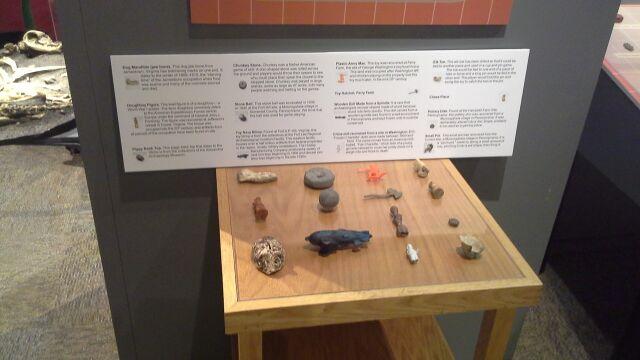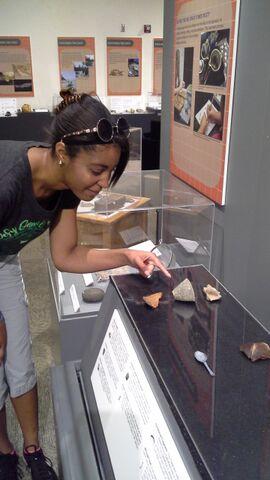Visualizing & Exhibiting Anthropology: VCU Students 3D Scan, Print & Hand Paint Hundreds of Artifacts for Virginia Museum of Natural History Exhibit
 3D scanning and printing allow us to come face to face with the future. After decades of talk about space age technologies, the wave of the future, and the technology of tomorrow, we can now literally hold it in our hands–and it all becomes even more amazing in tandem with other fields and sciences like virtual reality and robotics.
3D scanning and printing allow us to come face to face with the future. After decades of talk about space age technologies, the wave of the future, and the technology of tomorrow, we can now literally hold it in our hands–and it all becomes even more amazing in tandem with other fields and sciences like virtual reality and robotics.
We see traditional practices and processes falling away far more rapidly than we expected, and in such different but enormously advantageous ways than were previously fantasized about. With all that 3D printing and its surrounding technologies offer, we can walk into the future rather than just look into it. Ironically though, 3D scanning and 3D printing technology are also one of the keys to preserving our past–and the further we progress, the more this is evident–especially as we see projects like that of one between the Virtual Curation Laboratory at Virginia Commonwealth University (VCU) and the Virginia Museum of Natural History.
 For the past four years, VCU students working with VMNH’s Curator of Archaeology Dr. Elizabeth Moore have been working to 3D scan the museum’s archaeological and animal bone collections. Part of a project within the Department of Defense (DoD) Legacy Program, the group is now responsible for an enormous collection of 1800 objects all which share one thing–they have been discovered on DoD land from areas such as:
For the past four years, VCU students working with VMNH’s Curator of Archaeology Dr. Elizabeth Moore have been working to 3D scan the museum’s archaeological and animal bone collections. Part of a project within the Department of Defense (DoD) Legacy Program, the group is now responsible for an enormous collection of 1800 objects all which share one thing–they have been discovered on DoD land from areas such as:
- Jamestown
- Thomas Jefferson’s Poplar Forest
- George Washington’s Ferry Farm
- Mount Vernon
As this project and other museum activities progressed, Dr. Moore decided to take the whole group in another direction as well.
“Dr. Moore thought VCU students could help with a new archaeology exhibit she was planning, particularly those in a new class that I was teaching to use our various 3D scans to create museum exhibits entitled Visualizing and Exhibiting Anthropology,” Dr. Bernard Means, RPA Director of the Virtual Curation Laboratory, told 3DPrint.com.
Both Dr. Moore and Dr. Means had a vision where the students would be able to actually put together all the elements for a cohesive show, using some of the hundreds of 3D printed materials.
“Seeing all the objects spread out at these public events created as digital models from all over the world inspired the notion of integrating them into a dedicated archaeology exhibit,” Dr. Means told 3DPrint.com.
 As they embarked on creating the exhibit, the students were able to finish them in post-processing with hand-painting, using acrylics. Most of the post-processing relied on painting the printed replicas with acrylics. They either were able to paint the 3D printed replicas while looking directly at the originals or had to use photographs if artifacts remained in other locations after the team had traveled to scan them.
As they embarked on creating the exhibit, the students were able to finish them in post-processing with hand-painting, using acrylics. Most of the post-processing relied on painting the printed replicas with acrylics. They either were able to paint the 3D printed replicas while looking directly at the originals or had to use photographs if artifacts remained in other locations after the team had traveled to scan them.
“Some artifacts are literally one of a kind, and the host institutions would never loan them out for exhibit, but the sharing of a 3D printed replica of a 3D scan is not problematic at all,” stated Dr. Means.
The team used a NextEngine desktop 3D scanner for most of the objects, and then perfomed editing in ScanStudio and Rapidworks. According to Dr. Means, animations were created with Rhino, using the Bongo Plugin, and MeshMixer was used for modifying items for the exhibition. For some of the larger items, the team used a Sense 3D scanner, for artifacts such as a Colonial era cellar from George Washington’s Ferry Farm and a dog burial from an exhibit at The State Museum of Pennsylvania.
This was an extensive project for all involved, and students were able to experience something very unique, involving preservation of the past through the use of technology very new to them.
“I felt as though being involved in the process of creating the exhibit allowed me to gain a better understanding of how to work with a creative team to create a product. I’ve never collaborated with so many people and I think that it was valuable real world experience,” Erica Eddins, one of the students involved in the project, told 3DPrint.com. “There is nothing better than seeing all the work of yourself, peers, and professionals coming together to create a collective piece. My biggest hope is that what we created brings awareness to archaeology, along with how 3D printing can be used to visualize the past.”
Other students joined the project as they were working on 3D printing projects already in other classes with Dr. Means, and were able not only to bring their knowledge of the technology to the project, but were also able to learn a great deal about exhibits, archiving, and curation.
“I took this class at the same time as my internship with Dr. Means in the Virtual Curation Laboratory, so I was simultaneously gaining an understanding of 3D printing technology in the lab and learning how to best integrate it into our exhibit design in class. Students did not need to master the technology for this class, but it was important to understand why we were utilizing it in the design of our exhibit,” said Zoe Rahsman, also a participating student. “The 3D printed artifact replicas are reminiscent of the original artifacts, and could easily be used in the exhibit without fear of damaging or losing the original artifact. Additionally, this was an opportunity to present 3D printed technology to a wider public.”
 With this project, and exhibit, everyone was able to use the most basic benefits of 3D printing to their advantage–and for the advantage of the viewing public. Affordable replicas were easily made so that everyone could get an idea of the scope of the collection and the details of the artifacts–while they remained safely archived and preserved.
With this project, and exhibit, everyone was able to use the most basic benefits of 3D printing to their advantage–and for the advantage of the viewing public. Affordable replicas were easily made so that everyone could get an idea of the scope of the collection and the details of the artifacts–while they remained safely archived and preserved.
“3D scanning and 3D printing are excellent ways to share the heritage of peoples and cultures from distant places and times with people living anywhere on our planet today,” Dr. Means told 3DPrint.com. “Individuals can see and touch unique artifacts that they might otherwise never be able to see. Creating digital models of unique cultural items is a way to preserve them for future generations, and prevent them from being destroyed by contemporary social and political forces such as ISIS. 3D printing is important to the future of museums as well, as not only can they display 3D printed material that people can touch, but they can make available 3D digital models that can be downloaded at home or at school, enabling people to expand what and how they learn beyond the physical walls of a museum.”
Both Dr. Moore and Dr. Means have worked together in their goals to share archaeology and corresponding research with the public, and the overall project and resulting Visualizing and Exhibiting Anthropology exhibit is an inspiring achievement regarding creativity, the use of innovative and relevant new technology, and massive teamwork.
“It was exciting working with students on the exhibit, Exploring Virginia, and having access to the many artifacts that have been scanned by the VCU Virtual Curation Laboratory,” the Museum’s Dr. Moore told 3DPrint.com. “The students brought fresh ideas and perspectives to interpreting the past and presenting it to our visitors. The sheer variety of artifacts that were available allowed us to consider topics that might otherwise have been very difficult to present. Visitors don’t like to read a story on the wall, they like to see objects. When they can touch those objects, as they can with the 3D printed pieces, it makes an even richer and more personal experience. There is power in objects that words and photographs simply cannot convey.”
Discuss this story in the Virginia Museum of Natural History forum thread on 3DPB.com.
Subscribe to Our Email Newsletter
Stay up-to-date on all the latest news from the 3D printing industry and receive information and offers from third party vendors.
You May Also Like
Air Force Awards Fortius Metals $1.25M to Qualify 3D Printing Wire for Hypersonic Applications
AFWERX, part of the US Air Force Research Laboratory (AFRL), awarded a Direct-to-Phase II Small Business Innovation Research (SBIR) contract worth $1.25 million to Colorado’s Fortius Metals, to accelerate qualification...
US Air Force Awards JuggerBot $4M for Large-format Hybrid 3D Printing
Large-format 3D printer manufacturer JuggerBot has received a $4 million grant to develop a large format 3D printer, courtesy of the Under Secretary of Defense, Research and Engineering Manufacturing Technology...
Where Have All AM’s Unicorns Gone?
In the rapidly evolving world of 3D printing, startups valued at over a billion dollars, known as unicorns, once seemed as fantastical as the mythical creatures themselves. While a few...
How My Childhood Fascination with Planes Led to Investing in 3D Printing
My fascination with aerospace started young, and I started studying planes–identifying them in the sky and learning everything I could about how they work. Fast forward to my first week...

































